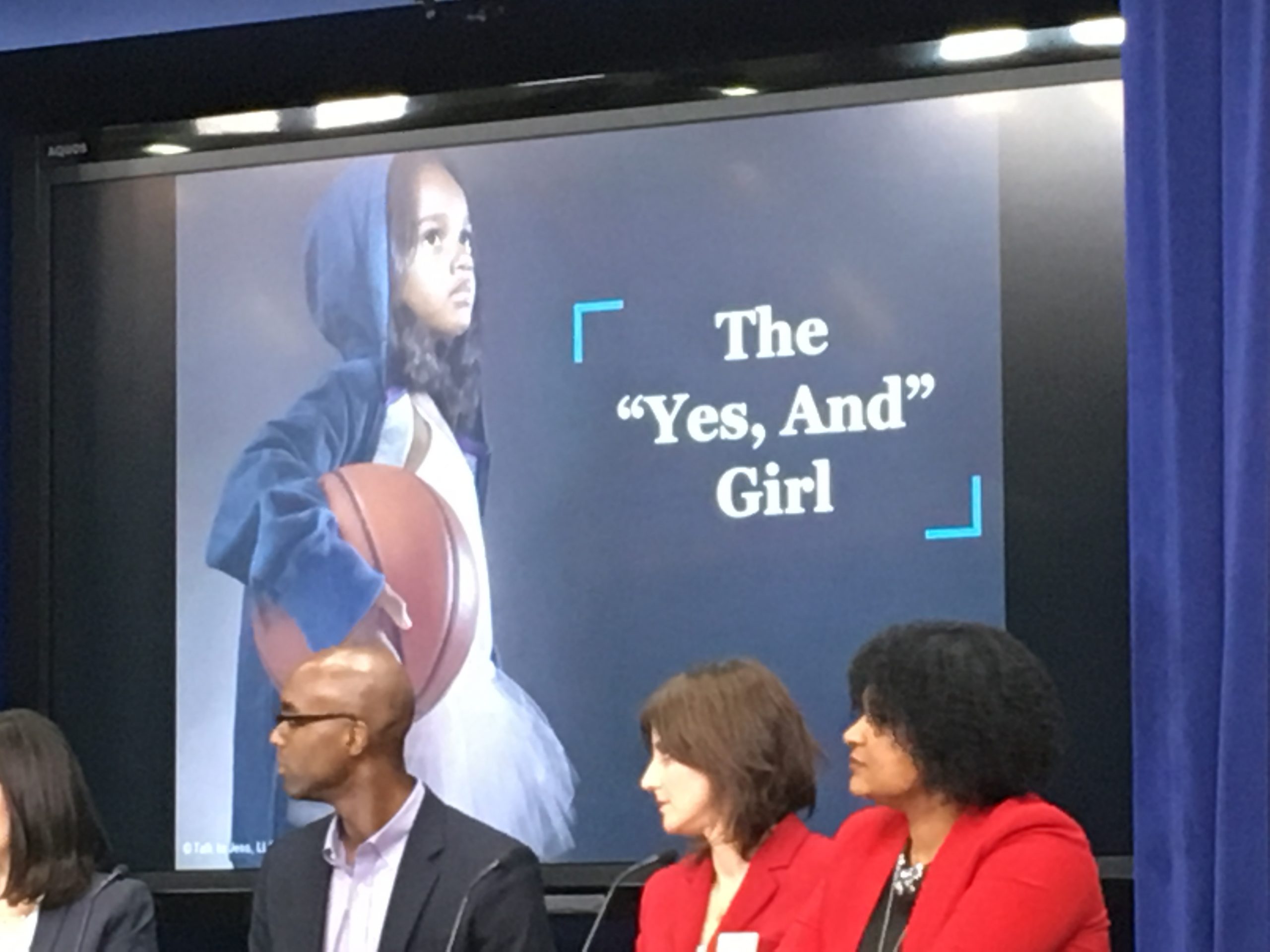Last week, Sandhya Nankani wrote about the White House Conference on gender and diversity in toys. Here she describes the toy industry’s efforts to break down existing stereotypes and create new narratives that empower girls.
 The toy world is abuzz with the recent launch of the newest Barbie doll, modeled after Misty Copeland, the first black female principal dancer at the American Ballet Theater. The doll is a part of Barbie’s Sheroes collection, which celebrates female heroes who “like Barbie, have broken boundaries, challenged gender norms and proven girls can be anything they want to be.”
The toy world is abuzz with the recent launch of the newest Barbie doll, modeled after Misty Copeland, the first black female principal dancer at the American Ballet Theater. The doll is a part of Barbie’s Sheroes collection, which celebrates female heroes who “like Barbie, have broken boundaries, challenged gender norms and proven girls can be anything they want to be.”
The Misty Copeland doll follows on the heels of the much-publicized launch earlier this year of Barbie’s Fashionistas collection that introduced a range of ethnicities as well as body types for the iconic dolls. These changes were made in a recognition of the need for Barbie to “stay relevant to culture and be more inclusive.”
Mattel is not the only toy company engaged with the challenge to diversify its product line. At a recent White House conference on breaking gender stereotypes in children’s media and toys, representatives from Mattel, Disney, and Lego shared fascinating case studies of their teams’ efforts to create new narratives and products that reflect the world of girls today.
From Disney, we heard about the “Dream Big Princess” campaign that aims to bring “the spirit of adventure and pulling it through Disney’s existing princess product line” by showcasing girls as champions with qualities of inner strength, bravery, and aspiration.
And, DC Comics has introduced the DC Super Heroes Girls line which introduces teenage versions of superheroes like Wonder Woman and Supergirl. The campaign wants to send the message to girls that “Yes, you can be the creator of your own stories.”
These large brands’ “If she can see it, she can be it” campaigns have clearly been inspired by research from places such as the Geena Davis Institute, which found that that “girls are nowhere to be scene” in films. And the research presented at the White House conference was surely meant to encourage them to amp up their commitments to pushing boundaries.
Presentations throughout the day looked at the representations of girls in the media—television, video games, advertising, and toys—and challenged creators of children’s content to reimagine the dominant narrative in TV and children’s media that focuses on the way girls look rather than what they can do and be. They also made clear the intersection of gender and race and the “epidemic of invisibility” that stalks the industry—sharing dramatic data that showed the absence of diverse representations of children of color and stereotype-free gender representations of girls. The new Comprehensive Annenberg Report on Diversity (CARD) study, for example, analyzed 11,306 speaking characters in 414 stories (see page 1), finding that 20% didn’t feature a single speaking black character and at least half or more of all cinematic, television, or streaming stories fail to portray one speaking or named Asian or Asian American on screen. Additionally, Dr. Kevin Clark shared revealing data about the absence of characters of color in video games, apps, and children’s books. (Listen to Dr. Clark in the Diversity in Apps podcast below.)
Further, the sexualization of young girls begins early, especially for girls of color as demonstrated by Fatima Goss Graves from the National Women’s Law Center, who shared her research findings on how race and gender stereotypes shape the school experiences of girls of color and result in opportunity gaps for them in education. She gave examples of the depiction of black girls as angry and oppressive, model minority Asian girls as quiet, passive or left out, or Latina girls as quick tempered. This hypersexualization of girls impacts their academic opportunities and leadership.
As the mother of a 6-year-old who carefully curates my daughter’s media intake and toy collection, I was profoundly struck by all this data. The power of media in early childhood is profound and cannot be ignored. As early as between the ages of 3 and 5, children discover gender constructions and and that by the time they reach age 8, they have learned to define themselves in relationship to or in context of the opposite sex.
And this is why we must pay attention to this study of over 7,000 Sears Toys catalogues which found that in the 1970s, less than 2% of toys were identified or branded as for either boys or girls. Today, the aisles of toy stores are color-coded and gendered marketing is the norm. This “genderification” of toys directly affects the choices that children make about what to play or not play with. Whether we like it or not, we live in a world where painting blocks pink “gives girls permission to play with blocks.” Another study by Lisa Dinella and her team showed that when “girls’ toys’ were painted white, boys played with them and that when ‘boys’ toys” were painted pink, girls played with them. Children broke down their own likes and dislikes and played with toys that crossed the gender divide such as blocks, trucks, and kitchen sets!
Such gendered branding and product construction can have profound effects on career choices that men and women make, the pay gap, and confidence levels of young girls. It’s all connected.
Therein lies the rub. I look around and I see an industry that is making concerted efforts to push gender boundaries by re-branding existing products to celebrate stereotypes and to shift the toy and children’s media industry to place more what a girl can do instead of just focusing on what a girl can look like.
But what we also need, the White House conference showed, are toys and media that disrupt existing narratives and retell the stories of girls and boys. Companies such as I am Elemental (girl action figures with core superpowers like wisdom and bravery), WonderCrew (dolls that combine action figures with the comfort of a stuffed animal), littleBits (gender neutral electronic building blocks), and buddingSTEM (clothing line that celebrates girls’ smarts and STEM) are doing incredible work to push the industry to a new place and changing the conversations at the design tables, marketing rooms, and store shelves so that we can get closer to making this statement by Lisa Dinella a reality: “There’s no such things as girl toys and boy toys. There’s just toys and there’s just kids. It’s our responsibility to make this statement true.”


